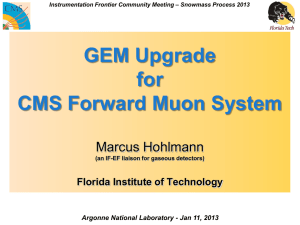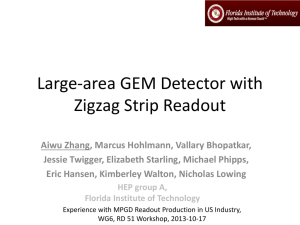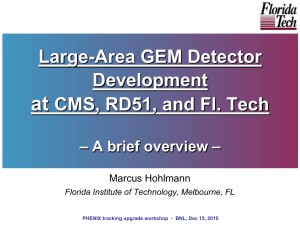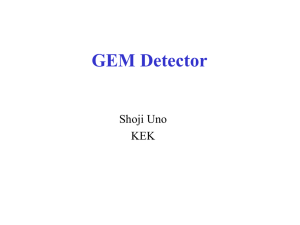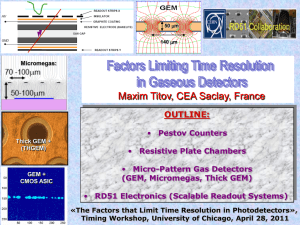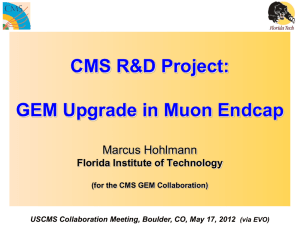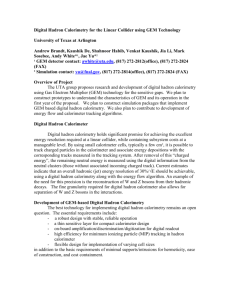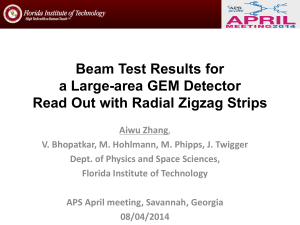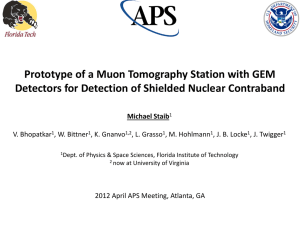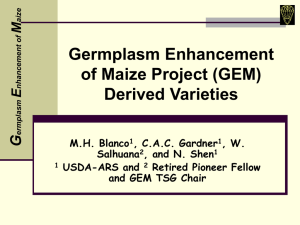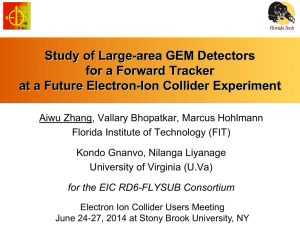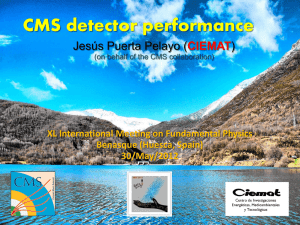PPT - Florida Institute of Technology
advertisement
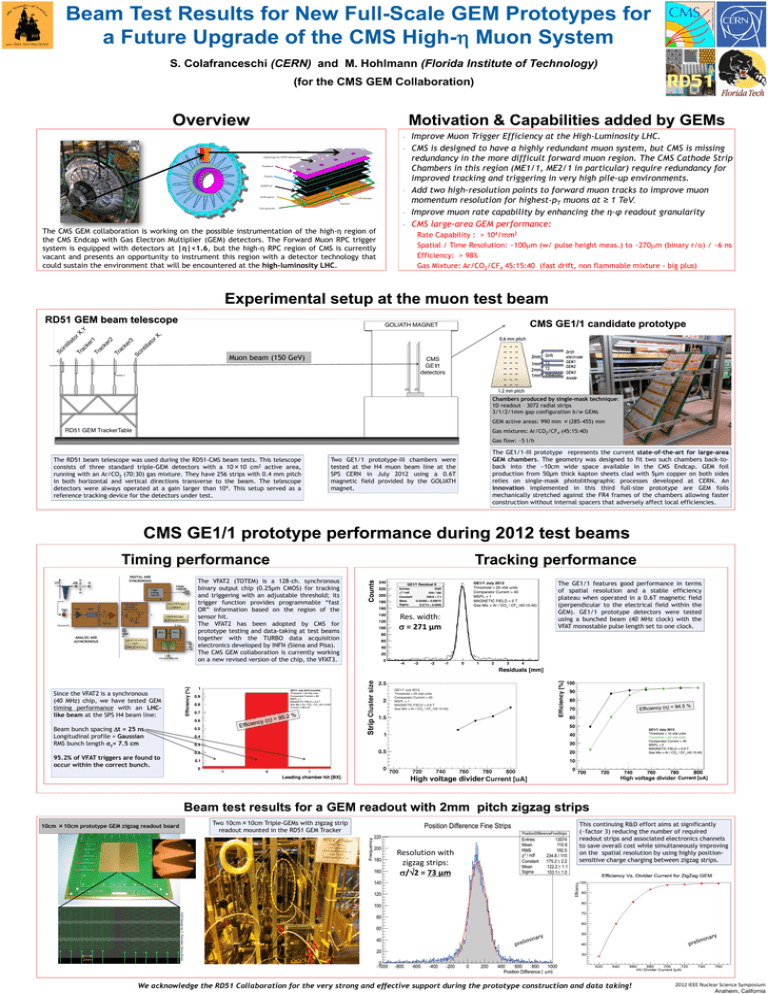
Beam Test Results for New Full-Scale GEM Prototypes for a Future Upgrade of the CMS High- Muon System S. Colafranceschi (CERN) and M. Hohlmann (Florida Institute of Technology) (for the CMS GEM Collaboration) Overview Motivation & Capabilities added by GEMs - - The CMS GEM collaboration is working on the possible instrumentation of the high-η region of the CMS Endcap with Gas Electron Multiplier (GEM) detectors. The Forward Muon RPC trigger system is equipped with detectors at |η|<1.6, but the high-η RPC region of CMS is currently vacant and presents an opportunity to instrument this region with a detector technology that could sustain the environment that will be encountered at the high-luminosity LHC. - Improve Muon Trigger Efficiency at the High-Luminosity LHC. CMS is designed to have a highly redundant muon system, but CMS is missing redundancy in the more difficult forward muon region. The CMS Cathode Strip Chambers in this region (ME1/1, ME2/1 in particular) require redundancy for improved tracking and triggering in very high pile-up environments. Add two high-resolution points to forward muon tracks to improve muon momentum resolution for highest-pT muons at ≥ 1 TeV. Improve muon rate capability by enhancing the η-φ readout granularity CMS large-area GEM performance: Rate Capability : > 104/mm2 Spatial / Time Resolution: ~100m (w/ pulse height meas.) to ~270m (binary r/o) / ~6 ns Efficiency: > 98% Gas Mixture: Ar/CO2/CF4 45:15:40 (fast drift, non flammable mixture - big plus) Experimental setup at the muon test beam RD51 GEM beam telescope CMS GE1/1 candidate prototype Muon beam (150 GeV) / Chambers produced by single-mask technique: 1D readout – 3072 radial strips 3/1/2/1mm gap configuration b/w GEMs GEM active areas: 990 mm ×(285-455) mm Gas mixtures: Ar/CO2/CF4 (45:15:40) Gas flow: ~5 l/h The RD51 beam telescope was used during the RD51-CMS beam tests. This telescope consists of three standard triple-GEM detectors with a 10×10 cm2 active area, running with an Ar/CO2 (70:30) gas mixture. They have 256 strips with 0.4 mm pitch in both horizontal and vertical directions transverse to the beam. The telescope detectors were always operated at a gain larger than 104. This setup served as a reference tracking device for the detectors under test. The GE1/1-III prototype represents the current state-of-the-art for large-area GEM chambers. The geometry was designed to fit two such chambers back-toback into the ~10cm wide space available in the CMS Endcap. GEM foil production from 50μm thick kapton sheets clad with 5μm copper on both sides relies on single-mask photolithographic processes developed at CERN. An innovation implemented in this third full-size prototype are GEM foils mechanically stretched against the FR4 frames of the chambers allowing faster construction without internal spacers that adversely affect local efficiencies. Two GE1/1 prototype-III chambers were tested at the H4 muon beam line at the SPS CERN in July 2012 using a 0.6T magnetic field provided by the GOLIATH magnet. CMS GE1/1 prototype performance during 2012 test beams Timing performance DIGITAL AND SYNCRONOUS Tracking performance The VFAT2 (TOTEM) is a 128-ch. synchronous binary output chip (0.25μm CMOS) for tracking and triggering with an adjustable threshold; its trigger function provides programmable “fast OR” information based on the region of the sensor hit. The VFAT2 has been adopted by CMS for prototype testing and data-taking at test beams together with the TURBO data acquisition electronics developed by INFN (Siena and Pisa). The CMS GEM collaboration is currently working on a new revised version of the chip, the VFAT3. ANALOG AND ASYNCRONOUS Res. width: = 271 µm The GE1/1 features good performance in terms of spatial resolution and a stable efficiency plateau when operated in a 0.6T magnetic field (perpendicular to the electrical field within the GEM). GE1/1 prototype detectors were tested using a bunched beam (40 MHz clock) with the VFAT monostable pulse length set to one clock. Strip Since the VFAT2 is a synchronous (40 MHz) chip, we have tested GEM timing performance with an LHClike beam at the SPS H4 beam line: Beam bunch spacing t = 25 ns Longitudinal profile = Gaussian RMS bunch length σz= 7.5 cm 95.2% of VFAT triggers are found to occur within the correct bunch. High voltage divider High voltage divider Beam test results for a GEM readout with 2mm pitch zigzag strips Two 10cm×10cm Triple-GEMs with zigzag strip readout mounted in the RD51 GEM Tracker 10cm ×10cm prototype GEM zigzag readout board Resolution with zigzag strips: /2 = 73 µm CAD Design by C. Pancake, Stony Brook 2mm This continuing R&D effort aims at significantly (~factor 3) reducing the number of required readout strips and associated electronics channels to save overall cost while simultaneously improving on the spatial resolution by using highly positionsensitive charge charging between zigzag strips. We acknowledge the RD51 Collaboration for the very strong and effective support during the prototype construction and data taking! 2012 IEEE Nuclear Science Symposium Anaheim, California





